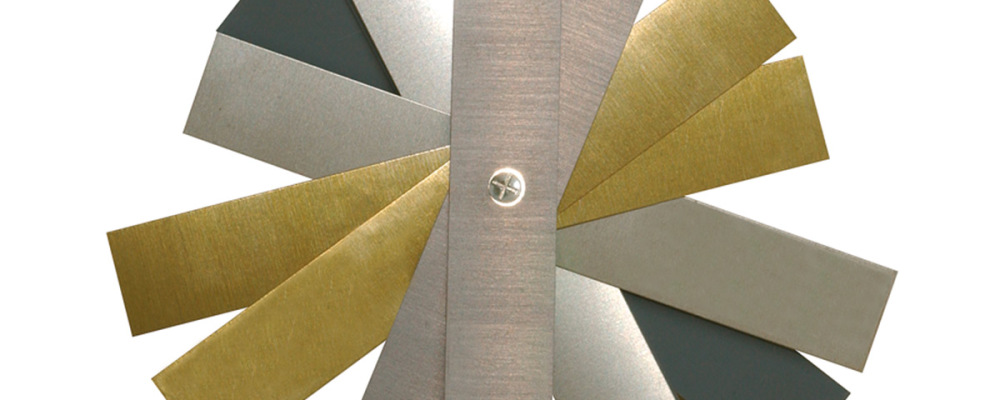
D28 - Varnish for non-oriented grades
The main purpose of varnish is to provide interlaminar insulation and to improve the punchability of steel.
 Download
Download
Available grades:
Properties
Electrical steel varnishes for non-oriented grades are designed to enhance the behaviour of fully processed electrical steels. Their main purpose is to provide interlaminar insulation and to improve the punchability of these steels. Each type has its own specific properties, such as insulation level, punchability effect, corrosion protection, temperature resistance and weldability; hence it is material use that determines the optimum choice of varnish. All varnishes have been selected and developed to be environmentally friendly: they are hydrosoluble and chromium-free.
Advantages
The C3-type varnish is based on synthetic resins, resulting in a product with excellent lubricating properties for the punching process: the coated sheet can be punched without the need for additional lubricant. The resins' chemical composition yields special advantages such as high elasticity and very strong adhesion. It is particularly recommended for automatic stacking processes. Typical gauges range from 1 to 4 µm per side. A coating thickness of less than 1 µm offers the additional advantage of excellent weldability, whereas 3 µm ensures good interlaminar insulation.
The C5-type varnish is a pigmented varnish, made with thermostable resins, mineral products and pigments.
For the EC-5-N varnish, the type of mineral products and the amount used have been selected to obtain a coating with excellent temperature resistance during prolonged thermal treatments, which is of particular interest where stress-relief annealing is required after punching. The composition of this varnish was designed to maintain its dielectrical properties during the repair of damaged copper windings. Additionally, the mineral part of the coating provides high thermal conductivity. The combination of resins and mineral products achieves a good compromise between corrosion protection and weldability. Typical gauges range from 1 to 4 µm per side.
The EC-5-P has an increased amount of organic components compared to the EC-5-N, in order to achieve a better punchability, whilst maintaining a good weldability. Typical gauges range from 1 to 2 µm per side.
The C6-type varnish is also a pigmented varnish, but is especially suitable for high-power rotating machines, thanks to its high electrical insulation level. The mineral elements have been selected to reduce punching tool wear and favour punching oil retention. They also enhance the rigidity of the varnish, which minimises dimensional changes under high pressure/temperature. This varnish is particularly recommended for use with contactors, to permit a higher flutter frequency whilst reducing noise. Typical gauges range from 4 to 10 µm per side. This varnish can also be provided in a formaldehyde-free version.
Applications
These coatings are used for fully processed grades, as well as for pole sheets in the cold rolled version, in a wide range of electrical applications such as rotating machines, transformers and contactors.
Recommendations for use
The raw materials used have a chemical composition - both in liquid and cured varnish state - which does not require specific protective measures during the processing of the coated steels or during use in a given application.
Brand correspondence
Full table
| |
EN 10342:2005 |
ASTM A976:2008 |
IEC/CEI 60404-1-1:2004 |
ArcelorMittal-Code |
Old brand names |
| C3 |
EC-3 |
C-3 |
EC-3 |
S |
|
| C5 |
EC-5-P |
C-5 |
EC-5-P |
T |
|
| C5 |
EC-5-N |
C-5 |
EC-5-N |
G |
|
| C6 |
EC-6 |
C-6 |
EC-6 |
M |
|
| C6 formaldehyde-free |
EC-6 |
C-6 |
EC-6 |
F |
|
C3
| |
C3 |
| EN 10342:2005 |
EC-3 |
| ASTM A976:2008 |
C-3 |
| IEC/CEI 60404-1-1:2004 |
EC-3 |
| ArcelorMittal-Code |
S |
C5
| |
C5 |
| EN 10342:2005 |
EC-5-P |
| ASTM A976:2008 |
C-5 |
| IEC/CEI 60404-1-1:2004 |
EC-5-P |
| ArcelorMittal-Code |
T |
C5
| |
C5 |
| EN 10342:2005 |
EC-5-N |
| ASTM A976:2008 |
C-5 |
| IEC/CEI 60404-1-1:2004 |
EC-5-N |
| ArcelorMittal-Code |
G |
C6
| |
C6 |
| EN 10342:2005 |
EC-6 |
| ASTM A976:2008 |
C-6 |
| IEC/CEI 60404-1-1:2004 |
EC-6 |
| ArcelorMittal-Code |
M |
C6 formaldehyde-free
| |
C6 formaldehyde-free |
| EN 10342:2005 |
EC-6 |
| ASTM A976:2008 |
C-6 |
| IEC/CEI 60404-1-1:2004 |
EC-6 |
| ArcelorMittal-Code |
F |
Prev grade
Next grade
Coating properties
| Designation |
C3 |
C5 |
C6 |
| Chemical composition |
Organic (synthetic resin) |
Inorganic (minerals, pigments) - Organic (synthetic resin) |
| Colour |
Gold |
Grey |
Grey blue |
| ArcelorMittal code |
S01 |
S12 |
S24 |
T01 |
T12 |
G01 |
G12 |
G24 |
M47 |
F47 |
M6D |
| Gauge (µm/side) |
< 1 |
1 to 2 |
2 to 4 |
< 1 |
1 to 2 |
< 1 |
1 to 2 |
2 to 4 |
4 to 7 |
6 to 10 |
| Typical insulation resistance (Ω.cm2/side) |
2 |
10 |
50 |
5 |
15 |
5 |
15 |
70 |
300 |
> 3000 |
| Temperature resistance (°C) Continuous / Intermittent |
180/600 (1) |
210/600 |
250/850 |
180/540 (1) |
| Main properties |
Punchability |
Punchability |
Heat resistance |
Insulation |
Insulation measurement: Franklin test according to the standard EN 60404-11:2013.
Continuous temperature resistance according to the standard IEC/CEI 60404-12:1992.
(1) In case of higher intermittent temperatures, please contact us.
All details provided in the ArcelorMittal Flat Carbon Europe S.A. catalogue are for information purposes only. ArcelorMittal Flat Carbon Europe S.A. reserves the right to change its product range at any time without prior notice.
For more information on our products, visit the document centre.